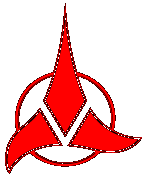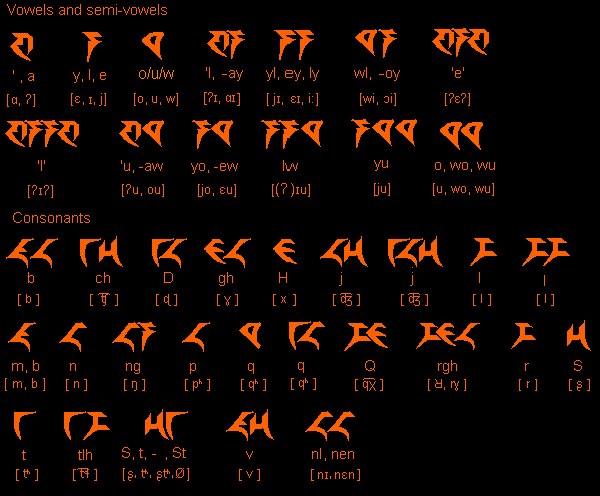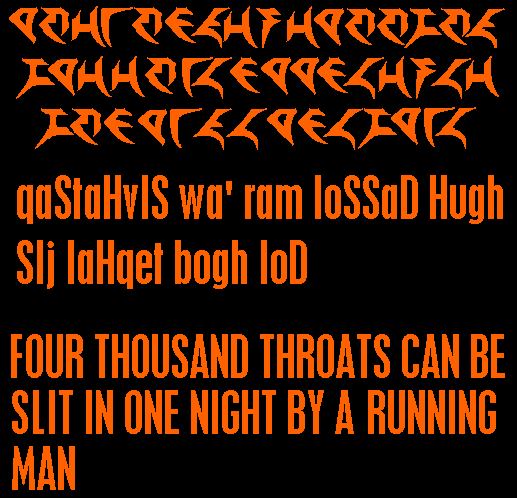 |
 |
 |
 |
 |
 |
 |
 |
 |
 |
 |
 |
 |
 |
 |
 |
 |
 |
 |
 |
 |
 |
 |
 |
 |
 |
 |
 |
 |
 |
 |
 |
 |
 |
 |
 |
 |
 |
 |
 |
 |
 |
|
|
The (more) canon Klingon writing system (gheq pIqaD) |
|
|
|
 |
|
|
|
The Klingon alphabet I have invented is based directly on the canon symbols used;in the TV series. The system is based on the the prinsiple of the digraph (letter combitations that represent one sound) It has to be likke this becasue with only 11 symbols it is very dificult not to use digraphs. The system is comparable to scottish Gaelic in this respect as gaelic only uses 18; roman letters to right well over 40 sounds, a similar alphabet was used in denmark; danish runes used only 16 rune letters to write a lot more than 16 sounds.. Below is the alphabet and a few notes on its use. [note, the top row indicates the klinogn romanised spelling, the bottom row is the international phonetic alphabet pronunciation]. |
|
|
|
The basic alphabet |
|
|
|
 |
|
|
|
Pronunciation |
|
|
|
 |
|
|
|
All digraphs can be pronounced as the individual sound they represent or as there component letters depending on where they occur e.g. The letters mamam-papap = b or mp.
The vowel ?e? is mostly not written at all except in cases where it may cause confusion e.g. m-p = b or be, m-I-p = mep, m-I-I-p = mIp.; In these cases the letter yey is used and double yey is used for I in other cases.
the letter rarar can be pronounced as /l/ or /r/ and the letter amam can be pronounced /b/ and /m/.
There are no set rules has to what pronunciation SaSaS-tatat can have in a word except it has multiple pronunciations and its spelling is preserved for etymological reasons (much like English 'gh').
The combinations tpS (j) and rr (l) are preserved for use in proper nouns and a few other disambiguitive spelling and are rarely used. q and the tn digraph for /q/ are used interchangeably.
nn is used for nI because nI is used for ng.
And remember "reading klingon, that's hard!"
Text is written from left-to-right top-to-bottom.; Each sentence is written on its own line (like a paragraph in english), depending on context, spaces can be placed between words but don't necessarily have to be and in many cases sentences are written as continuious strings of glyphs..
Punctuation is occaisionally used but isn't necessary: - |
|
|
|
Klinogn numbers and abbreviations for colours, that are used on the bulkheads of kliogn ships to designate deck numbers and sections. |
|
|
|
 |
|
|
|
 |
|
|
|
Sample text |
|
|
|
 |
|
|
|
Links |
|
|
|
http://www.kli.org |
|
|
|
A very good site with information dealing with the Klingon language. Available in many diffrenrent languages. |
|
|
|
|
|
http://www.klingonska.org/ |
|
|
|
Another good site with a lot of information on the klinogn language, the KLI pIqaD and also canon kliong texts (including paramount pIqaD). Available in english and some swedish. |
|
|
|
|
|
 |
|
 |
|
|
|
|
|
Contact Greig at [email protected] |
|
|
|
By Greig isles [gheq 'ayleS]
DISCLAIMER:; All images owned by paramount and used here non commercially. Paramount has the right to obliterate this site if they want. |
|
|
|
 |
|
|
|
Visitors since 7th Febuary 2003 |
|
|
|








